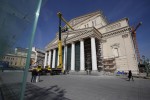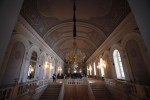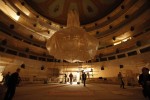 Moscow’s Bolshoi Theater is finally set to reopen in October after over six years of troubled reconstruction. The theater was originally scheduled to reopen in 2009, but the date was pushed back repeatedly under a cloud of accusations of subcontractor improprieties. It looks like the end is finally in sight, however, and judging from the pictures, the new old Bolshoi will be gorgeous, which it better be because it has cost roughly $660 million, 16 times over the original estimate.
Moscow’s Bolshoi Theater is finally set to reopen in October after over six years of troubled reconstruction. The theater was originally scheduled to reopen in 2009, but the date was pushed back repeatedly under a cloud of accusations of subcontractor improprieties. It looks like the end is finally in sight, however, and judging from the pictures, the new old Bolshoi will be gorgeous, which it better be because it has cost roughly $660 million, 16 times over the original estimate.
This makes the third major renovation the theater has seen since it opened in 1825 as the Imperial Bolshoi Theatre of Moscow. The first one was after it burned down in 1853 leaving only the exterior walls and the main colonnade standing, and the second after it was bombed during World War II.
 This reconstruction is the biggest of them all since it involves a complete rebuilding from the ground up — architects estimated that a full 75% of the structure was in precarious condition — removing the bizarre and inexplicable alterations the Soviets abused the poor building with, and restoring all the decorative elements, from red velvets to coats of arms, to their glamorous tsarist origins. Given all that, it’s perhaps understandable that this restoration has taken more than twice as long as the 1853 one. I’m sure the whole massive embezzlement and fraud situation and the government having to fire and replace several shady subcontractors didn’t help either.
This reconstruction is the biggest of them all since it involves a complete rebuilding from the ground up — architects estimated that a full 75% of the structure was in precarious condition — removing the bizarre and inexplicable alterations the Soviets abused the poor building with, and restoring all the decorative elements, from red velvets to coats of arms, to their glamorous tsarist origins. Given all that, it’s perhaps understandable that this restoration has taken more than twice as long as the 1853 one. I’m sure the whole massive embezzlement and fraud situation and the government having to fire and replace several shady subcontractors didn’t help either.
The company said some 3,500 construction workers are still busy adding sophisticated electronic and hydraulic devices, redesigning the stage floor to ease the ballet dancers’ pain and completing an underground stage located just 30 meters (yards) from a metro station.
“Directors could do things that were impossible before,” said Summa Capital’s spokesman, Mikhail Sidorov. […]
Soviet founder Vladimir Lenin wanted to close the ornate theater, which he saw as a symbol of decadent aristocracy, but the Communists ended up using the theater for party gatherings. Lenin’s death was announced from the theater’s stage, and the troupe was twice awarded the Order of Lenin, the Soviet Union’s highest award.
While the ballet and opera corps enjoyed generous benefits and tirelessly toured the world, the building’s acoustics were crippled by the remodeling of the hall and the filling of a gigantic hollow resonator under the orchestra pit with concrete.
Not just the acoustics were crippled by that crazy concrete fill. The stage was raised and glued to the block leaving no give whatsoever in the floor. The original wood floor was flexible, built on nine wooden supports. It not only resonated along with the music, but it provided an appropriately enveloping surface for dancing. Since the 1920s, the world-famous dancers of the Bolshoi Theater have had to dance on concrete in their headquarters. This is not kind to their already busted feet.
The Soviets also lifted the orchestra platform, installed the electric house lighting apparatus under the stage and extended the stage floor over the orchestra pit, thereby ensuring that a good chunk of the pit was inaccessible to the orchestra. That made some operas impossible for the Bolshoi to stage, like most of Wagner’s repertoire and a goodly portion of Strauss’s, because they couldn’t seat all the necessary instruments.
 The reconstruction has also rebuilt the wooden ceiling above the audience. It was originally a hanging ceiling that vibrated and reflected sound, distributing the sound evenly all over the house. The Soviets tightened the soundboard to the framework, which is the architectural equivalent of squashing the back and front of a violin together and expecting it to play anyway. Why they did all this crazy stuff, I do not know, but I suppose we should be glad they didn’t just knock the whole thing down like Lenin wanted.
The reconstruction has also rebuilt the wooden ceiling above the audience. It was originally a hanging ceiling that vibrated and reflected sound, distributing the sound evenly all over the house. The Soviets tightened the soundboard to the framework, which is the architectural equivalent of squashing the back and front of a violin together and expecting it to play anyway. Why they did all this crazy stuff, I do not know, but I suppose we should be glad they didn’t just knock the whole thing down like Lenin wanted.
The theater is scheduled to open on Oct. 2, 2011 with a production of Glinka’s 1842 opera Ruslan and Lyudmila based on Pushkin’s epic poem of the same name.
The Soviets also created a two headed dog, so maybe they knew what they were doing here.
Forgot to sign in.
No matter what the changing ideologies might be for a country, it seems nearly impossible to escape the past–a fortunate example of which is this project.
I suppose filling a resonator with concrete is at least as sensible as grafting extra heads onto dogs.